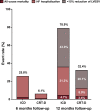Upgrade of right ventricular pacing to cardiac resynchronization therapy in heart failure: a randomized trial
- PMID: 37632437
- PMCID: PMC10590127
- DOI: 10.1093/eurheartj/ehad591
Upgrade of right ventricular pacing to cardiac resynchronization therapy in heart failure: a randomized trial
Abstract
Background and aims: De novo implanted cardiac resynchronization therapy with defibrillator (CRT-D) reduces the risk of morbidity and mortality in patients with left bundle branch block, heart failure and reduced ejection fraction (HFrEF). However, among HFrEF patients with right ventricular pacing (RVP), the efficacy of CRT-D upgrade is uncertain.
Methods: In this multicentre, randomized, controlled trial, 360 symptomatic (New York Heart Association Classes II-IVa) HFrEF patients with a pacemaker or implantable cardioverter defibrillator (ICD), high RVP burden ≥ 20%, and a wide paced QRS complex duration ≥ 150 ms were randomly assigned to receive CRT-D upgrade (n = 215) or ICD (n = 145) in a 3:2 ratio. The primary outcome was the composite of all-cause mortality, heart failure hospitalization, or <15% reduction of left ventricular end-systolic volume assessed at 12 months. Secondary outcomes included all-cause mortality or heart failure hospitalization.
Results: Over a median follow-up of 12.4 months, the primary outcome occurred in 58/179 (32.4%) in the CRT-D arm vs. 101/128 (78.9%) in the ICD arm (odds ratio 0.11; 95% confidence interval 0.06-0.19; P < .001). All-cause mortality or heart failure hospitalization occurred in 22/215 (10%) in the CRT-D arm vs. 46/145 (32%) in the ICD arm (hazard ratio 0.27; 95% confidence interval 0.16-0.47; P < .001). The incidence of procedure- or device-related complications was similar between the two arms [CRT-D group 25/211 (12.3%) vs. ICD group 11/142 (7.8%)].
Conclusions: In pacemaker or ICD patients with significant RVP burden and reduced ejection fraction, upgrade to CRT-D compared with ICD therapy reduced the combined risk of all-cause mortality, heart failure hospitalization, or absence of reverse remodelling.
Keywords: Cardiac resynchronization therapy; Heart failure; Pacing-induced cardiomyopathy; Right ventricular pacing; Upgrade.
© The Author(s) 2023. Published by Oxford University Press on behalf of the European Society of Cardiology.
Figures




References
-
- Kiehl EL, Makki T, Kumar R, Gumber D, Kwon DH, Rickard JW, et al. . Incidence and predictors of right ventricular pacing-induced cardiomyopathy in patients with complete atrioventricular block and preserved left ventricular systolic function. Heart Rhythm 2016;13:2272–8. 10.1016/j.hrthm.2016.09.027 - DOI - PubMed
Publication types
MeSH terms
Grants and funding
LinkOut - more resources
Full Text Sources
Medical
Research Materials

